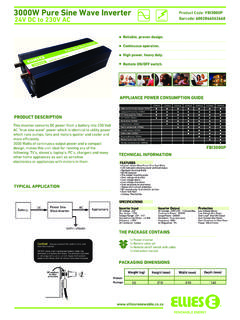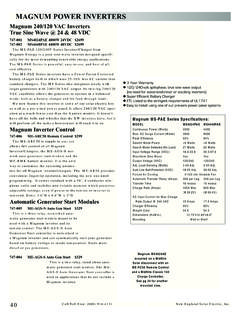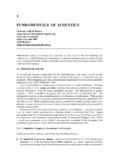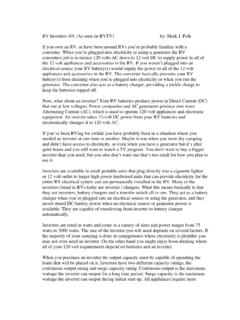Transcription of Zero Sequence Harmonics - Hammond Power …
1 zero Sequence Harmonics THE PROBLEM DEFINING Harmonics Harmonics , in an electrical Power system, are currents and voltages with frequencies that are integer multiples of the fundamental Power frequency. That is, in a Power system with a fundamental frequency of 60 Hz, the second harmonic is 120 Hz, the third harmonic is 180 Hz, etc. Harmonic currents are created by non-linear loads that generate non-sinusoidal currents. Harmonic currents, acting in an Ohm's Law relationship with the source impedances, produce harmonic voltages. The harmonic currents and voltages produced by balanced, three phase, non-linear loads are positive Sequence Harmonics (phasors displaced by 120 degrees, with the same rotation as the fundamental frequency), and negative Sequence Harmonics (phasors displaced by 120 degrees, with a reversed rotation).
2 However, harmonic currents and voltages produced by single phase, non-linear loads, which are connected phase to neutral in a three phase, four wire system, are third order, zero Sequence Harmonics (the third harmonic and its odd multiples - 3rd, 9th, 15th, 21st, etc., etc., phasors displaced by zero degrees). These third order, zero Sequence harmonic currents, unlike positive and negative Sequence harmonic currents, do not cancel but add up arithmetically at the neutral bus. SOURCE OF THIRD ORDER, zero Sequence Harmonics High levels of third order, zero Sequence Harmonics are principally the by-product of switch mode Power supply technology, which is used in modern office equipment and lighting systems as well as in virtually all other low Power electronic devices.
3 These Power supplies are efficient, small, light weight, low cost, and are in all other respects, highly suited to their task. Electrically, the AC source voltage of these devices is rectified to DC voltage and then used to charge a large capacitor. In one half cycle, the capacitor is charged to the average value of the voltage sine wave. The electronic equipment then draws current from the charged capacitor, to a regulated lower limit, to Power the device's circuitry. Before reaching that lower limit, the capacitor is again recharged to the average value in the next half cycle of the sine wave. This process, which is repeated twice in each cycle, causes AC current to flow only during a portion of the AC voltage wave in abrupt pulses.
4 During the rest of the wave, when the voltage is below the capacitor's residual, the capacitor draws no current. Equipment containing switch mode Power supplies includes personal computers, mainframe terminals, printers, photocopiers, facsimile machines and electronic ballasts in fluorescent lighting fixtures. On average, the zero Sequence (180 Hz) current generated by these devices exceeds 80% of the fundamental (60 Hz.) current consumed. For example, one electronic ballast, which consumes Amperes fundamental current, was found to generate Amperes third order, zero Sequence current (87% of the fundamental). In isolation, these rather small non-linear loads may seem insignificant.
5 However, in the numbers found in today's modern offices and data centers, their impact may be costly and even dangerous. EFFECT OF THIRD ORDER, zero Sequence Harmonics Significant levels of third order, zero Sequence harmonic current and voltage in a low voltage (ie. 120/208V), three phase, four wire system will have a severe impact on both the Power distribution system and the devices connected to it. In considering the extent of this Power quality problem, it is important to understand that, unlike positive and _____ _____ Hammond Power Solutions Inc. Literature Code: HPS-TA15 zero Sequence HarmonicsPage 2 of 3 negative Sequence Harmonics , zero Sequence Harmonics do not normally propagate into the higher voltage levels of the distribution system.
6 They are contained within the low voltage distribution transformer and its secondary four wire system. Depending upon the capacity and configuration of the distribution system, the presence of third order, zero Sequence currents may include any or all of the following symptoms: * High Neutral Current * High Neutral to Ground Voltage (Common Mode Noise) * High Peak Phase Current * High Average Phase Current * High Total Harmonic Distortion of the Current * High Total Harmonic Distortion of the Voltage * High Transformer Losses * High System Losses * Apparatus Overheating * Low Power Factor * Electronic Protective Device Malfunction * High Telephone Interference Factor * Increased Apparatus Vibration Ironically, the devices which create the third order, zero Sequence Harmonics may be the most sensitive to the problems they create.
7 The performance of the switch mode Power supply, in particular the charging of its capacitor, is critically dependent on the magnitude of the peak voltage. These voltage Harmonics can cause "flat topping" of the voltage waveform or lowering of the peak voltage. In severe cases the computer may reset due to its own Power supply's failure. THE SOLUTION FINDING Harmonics There are a number of practical steps that can be taken to confirm the presence of Harmonics in the electrical Power system (the inclusion of these procedures in a predictive/preventive maintenance program is fundamental to assuring Power quality).
8 1. As a first step, tour the facility to determine the types of equipment that are connected to the low voltage system. If this inventory includes the types of office equipment listed earlier, or electronic ballasts, Harmonics are likely present. 2. Locate the low voltage Power transformers that feed these non-linear loads and check for excessive heating. Remember that the Harmonics will increase the transformers' losses and cause them to overheat at loads below nameplate ratings. Third order, zero Sequence harmonic currents may also result in the overloading of the transformers' neutral terminals. Neutral currents may exceed phase currents under these harmonic conditions.
9 3. Using "True-RMS" (root-mean-square or equivalent heating value) meters, measure the phase and neutral currents and the phase to neutral voltages at the low voltage Power transformers' secondary terminals. Again, under zero Sequence harmonic conditions, the neutral currents will exceed the vector addition of the three phase currents. Under severe conditions, the neutral currents may substantially exceed phase currents under balanced conditions. These conditions give positive identification of a third order, zero Sequence problem. If "Average Responding" meters are also available, further proof may be obtained by repeating the above tests and comparing the results.
10 If the current and voltage waveforms are sinusoidal, the results of both measurements will be the same. Since "Average Responding" meters are only accurate under pure sine wave conditions, any distortion of the waveform will cause the "Average Responding" meter to read low. This reading may be as much as 50% lower than the "True-RMS" reading. By dividing the results of the "Average Reading" meter by the "True-RMS" meter, _____ _____ Hammond Power Solutions Inc. Literature Code: HPS-TA15 zero Sequence HarmonicsPage 3 of 3 one may obtain an "A/R" Ratio.












